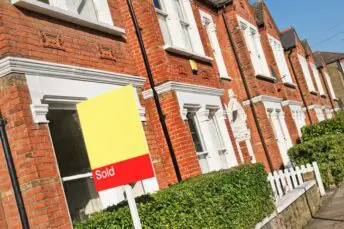House Price Watch Mar 2023
The housing market continues to experience a readjustment in house prices as annual house price growth slows to 1.3% this month; the slowest rate of annual growth since November 2019. However, there are early signs that the market is stabilising as mortgage rates begin to settle around 4%. There appears to be a better balance between buyers and sellers but with mortgage rates double where they were a year ago, and stretched affordability as a result, we still expect a slower period for the housing market and further price adjustment in the months ahead.
What’s happening nationally
House prices are down on average -0.3% in the past month and annual house price growth has slowed to +1.3%.
The indices are showing a range of house price movements over the past month. Nationwide and Land Registry are showing a drop, while Halifax and Rightmove, saw house prices increase in March.
Indices based on:
Land Registry – registered property transactions in February.
Nationwide & Halifax – mortgage valuations in March.
Rightmove – asking prices posted on Rightmove in March.
*Rightmove is not included in the index average as the basis for its index is different (asking price vs agreed sale price)
| Index reports: | Monthly change | Annual change |
|---|---|---|
| Land registry | -1.0% | +5.5% |
| Nationwide | -0.8% | -3.1% |
| Halifax | +0.8% | +1.6% |
| Rightmove | +0.8% | +3.0% |
| Average change | -0.2% | +2.4% |
House prices in your area
House prices have fallen over the past month in most areas.
Average house prices are highest in London (£532K) and lowest in the North East (£160K).
House price growth varies by property type. Detached (+7.2%), semi detached (5.9%) and terraced (7.0%) homes have seen the biggest rise and flats/ maisonettes the smallest (+2.1%) according to February Land Registry data.
| UK Region | Average price £ | Monthly change | Annual change |
|---|---|---|---|
| England | |||
| Nothern Ireland | |||
| Scotland | |||
| Wales | |||
| North West | |||
| Yorkshire and The Humber | |||
| North East | |||
| West Midlands | |||
| East Midlands | |||
| South West | |||
| East of England | |||
| South East | |||
| London |
| UK City | Average price | Annual change |
|---|---|---|
Market Monitor
There were 90K transactions in February, 4% lower than January and 18% lower than February last year. 90K transactions is below the usual level for this time of year based on recent years.
Demand continues to fall as do new instructions. Average level of stock per agent is relatively stable.
Time to sell is 57 days (slower than the average of 41 days over the last 12 months).
How busy is the market?
- Not busy
- Normal
- Very busy
- Transactions down in February, below typical transactions for this time of year
- Total transactions in February 900K
- -4% from last month
- -18% from February last year
Homes for sale vs homebuyers
- Good availability of homes
- Normal
- Shortage of homes
- Buyer enquiries continue to fall(-29% RICS); eleventh monthly drop
- Seller enquiries down (-6% RICS)
- Average stock per agent 43; up from 42 last month (incl under offer/ Sold STC Rightmove)
Average speed of sale
- Fast
- Normal
- Slow
- 57 days to find a buyer down from 62 days (12 month average 41 days Rightmove)
What the experts say
Rightmove - agent's view

“The beginning of the spring season sees stability and confidence continuing to return to the market as it recovers from the turbulence at the end of 2022. The pace of the market reached an unsustainable level in the last two years, and was on track to slow to a more normal level, though the speed of this slowdown to more normality was accelerated by the reaction to September’s mini-Budget. While higher mortgage rates and economic headwinds raise challenges, many potential home movers who were effectively side-lined in the frenetic bidding wars of the last two years will find that a slower-paced market gives them time to plan and secure their next move as we enter the traditionally busy spring-buying season.”
Nationwide

“March saw a furthe decline in house price growth. The housing market reached a turning point last year as a result of the financial market turbulence which followed the mini-Budget. Since then, activity has remained subdued – the number of mortgages approved for house purchase remained weak at 43,500 cases in February, almost 40% below the level prevailing a year ago. It will be hard for the market to regain much momentum in the near term since consumer confidence remains weak and household budgets remain under pressure from high inflation. Housing affordability also remains stretched, where mortgage rates remain well above the lows prevailing at this point last year.”
Halifax

“Overall the latest figures suggest relative stability in the housing market at the start of 2023 and align with many other recent industry surveys and data. This has been characterised by a partial recovery in activity and transactions, especially when compared to the significant drops seen at the end of last year, with latest Bank of England data showing mortgage approvals rising for the first time in six months. The principal factor behind this improved picture has been an easing of mortgage rates. It’s also important to recognise that the labour market, a key indicator for house prices, remains strong, with unemployment at a historical low of 3.7%, and pay growth continues to look robust. While the path for interest rates is uncertain, mortgage costs are unlikely to get significantly cheaper in the short-term and the performance of the housing market will continue to reflect these new norms of higher borrowing costs and lower demand. Therefore, we still expect to see a continued slowdown through this year.”
Zoopla (Hometrack)

“The sales market continues to see a return of buyers with more new sales being agreed. The shift towards lower mortgage rates has improved market activity. In recent weeks, the demand for homes reached its highest level since last October when the fallout of the minibudget hit activity. Demand is 16% higher than this time in 2019. Sales agreed are 16% lower than this time last year (demand is 43% lower), but 11% higher than 2019 levels and on an upward trajectory. Sellers continue to make modest downward adjustments to asking prices. This ensures pricing matches what buyers are prepared to pay. At the same time, they are accepting discounts to the asking price averaging 4%. There is no evidence of a major mismatch between buyers and sellers that would suggest house prices and transaction volumes are going to suddenly drop lower.”
RICS

“The results of the March 2023 RICS UK Residential Survey continue to depict a generally weak market backdrop, with indicators on demand, sales, new listings and house prices all remaining in negative territory. Moreover, near-term expectations suggest this pattern will remain in place for a while longer amid the tighter lending environment. That said, the twelve month view on sales volumes has improved in the latest feedback, with respondents anticipating a more stable trend coming through further ahead.”




